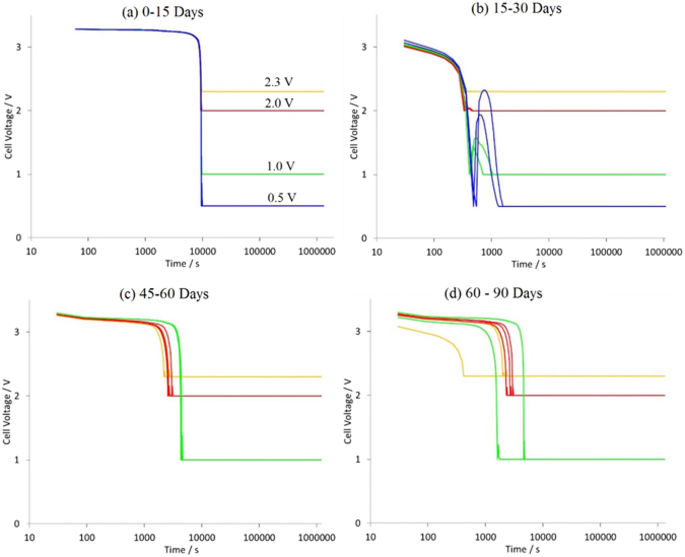Our official English website, www.x-mol.net, welcomes your
feedback! (Note: you will need to create a separate account there.)
Transportation Safety of Lithium Iron Phosphate Batteries - A Feasibility Study of Storing at Very Low States of Charge.
Scientific Reports ( IF 3.8 ) Pub Date : 2017-07-11 , DOI: 10.1038/s41598-017-05438-2
Anup Barai , Kotub Uddin , Julie Chevalier , Gael H. Chouchelamane , Andrew McGordon , John Low , Paul Jennings
Scientific Reports ( IF 3.8 ) Pub Date : 2017-07-11 , DOI: 10.1038/s41598-017-05438-2
Anup Barai , Kotub Uddin , Julie Chevalier , Gael H. Chouchelamane , Andrew McGordon , John Low , Paul Jennings

|
In freight classification, lithium-ion batteries are classed as dangerous goods and are therefore subject to stringent regulations and guidelines for certification for safe transport. One such guideline is the requirement for batteries to be at a state of charge of 30%. Under such conditions, a significant amount of the battery's energy is stored; in the event of mismanagement, or indeed an airside incident, this energy can lead to ignition and a fire. In this work, we investigate the effect on the battery of removing 99.1% of the total stored energy. The performance of 8Ah C6/LiFePO4 pouch cells were measured following periods of calendar ageing at low voltages, at and well below the manufacturer's recommended value. Battery degradation was monitored using impedance spectroscopy and capacity tests; the results show that the cells stored at 2.3 V exhibited no change in cell capacity after 90 days; resistance rise was negligible. Energy-dispersive X-ray spectroscopy results indicate that there was no significant copper dissolution. To test the safety of the batteries at low voltages, external short-circuit tests were performed on the cells. While the cells discharged to 2.3 V only exhibited a surface temperature rise of 6 °C, cells at higher voltages exhibited sparks, fumes and fire.
中文翻译:

磷酸铁锂电池的运输安全-在非常低的充电状态下储存的可行性研究。
在货运分类中,锂离子电池被归类为危险品,因此必须遵守严格的法规和安全运输认证指南。一种这样的准则是要求电池的充电状态为30%。在这种情况下,会存储大量的电池能量。如果管理不善,或者实际上是发生空侧事故,这种能量会导致起火和起火。在这项工作中,我们研究了去除99.1%的总存储能量对电池的影响。8Ah C 6 / LiFePO 4的性能袋式电池是在低电压下压延老化后,在等于或低于制造商建议值的条件下测量的。使用阻抗光谱法和容量测试监测电池退化;结果表明,在2.3 V下储存的电池在90天后没有显示出容量变化。电阻上升可忽略不计。能量色散X射线光谱分析结果表明没有明显的铜溶解。为了测试低压电池的安全性,对电池进行了外部短路测试。放电至2.3 V的电池仅显示6°C的表面温度升高,而电压较高的电池则显示出火花,烟雾和火。
更新日期:2017-07-11
中文翻译:

磷酸铁锂电池的运输安全-在非常低的充电状态下储存的可行性研究。
在货运分类中,锂离子电池被归类为危险品,因此必须遵守严格的法规和安全运输认证指南。一种这样的准则是要求电池的充电状态为30%。在这种情况下,会存储大量的电池能量。如果管理不善,或者实际上是发生空侧事故,这种能量会导致起火和起火。在这项工作中,我们研究了去除99.1%的总存储能量对电池的影响。8Ah C 6 / LiFePO 4的性能袋式电池是在低电压下压延老化后,在等于或低于制造商建议值的条件下测量的。使用阻抗光谱法和容量测试监测电池退化;结果表明,在2.3 V下储存的电池在90天后没有显示出容量变化。电阻上升可忽略不计。能量色散X射线光谱分析结果表明没有明显的铜溶解。为了测试低压电池的安全性,对电池进行了外部短路测试。放电至2.3 V的电池仅显示6°C的表面温度升高,而电压较高的电池则显示出火花,烟雾和火。

































 京公网安备 11010802027423号
京公网安备 11010802027423号